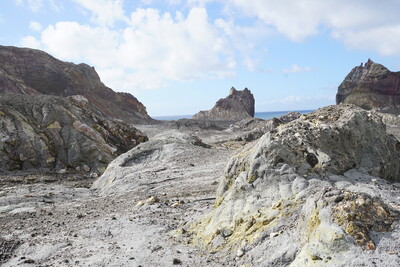
White Island, New Zealand
Fur Seals, Extremophiles and the Lure of Probability
Day 1: Gale force winds and ocean-occluding rain storms make White Island inaccessible by boat or helicopter. The probability of reaching White Island seems to bear a fruitless fate.
Day 2: The ocean, still violent from atmospheric decree, prevents a boat charter; however, a pocket of time before the next torrent allows for helicopter access.

Island of the Future – a Note on Scalar Bigotry
(10:30 a.m.) What is White Island? White island is a speculation, a virgin-scape, an allegory. Other than being an active marine volcano in the Bay of Plenty, it is also an active probability of life to come, or rather, life to predominate. The island has developed a language separate from ours, a language that foretells a fate of boiling seas, lakes of acid and skies that rain alkalizing metals. At present, its communities of bacteria and micro-fauna exist at a scale barely perceptible to the hominid. But, with rapid grace, novel universes are being incubated here. New taxa are on the rise. Humankind must slough away its scalar bigotry as the island reminds us that presence is something not commensurate with size. White Island has equipped itself for uncertainty, for endurance, for xenomorphic horizons we have only begun to imagine. It sits contented in a field of gaseous yellow vents and bubbling black tide pools.

Nutritious Effluent – the Outer Gate
From afar, White Island is surrounded, from shoreline to varying stretches of open ocean, by amorphous orbits of pastel-green-to-chartreuse water, slurry-like, and seemingly holding a different density than the Bay of Plenty’s characteristic sparkling, mouthwash-azure water. This is geothermal leakage, the volcano’s effluent. From the sky the acidic lake pooled inside the crater resembles a secreting mouth issuing, at different rates, steaming trails of drool that snake their way through the landscape of sodden ash and polished white rock. These mineral-rich, heated waters will eventually travel through the systems of both micro- and mega-fauna to promote a fringing underwater habitat; more aptly, a sulfuric barrier that interviews the metabolisms of island guests before they ascend to land. This is the outer gate.

The Fur Seal – the Inner Gate
Approaching White Island, under the machined massage of helicopter blades, I first encounter a pack of Fur Seals sunning themselves amidst the scarce vegetation that covers the wind-free side of the island. Their pelts are darkened from a recent swim, or a morning hunt. I can see the chromatic shift of drying fur go from petroleum-black coffee to a smoky tan, grey-blonde, a sheen only a flippered mammal could have. From pup to parent, they look more like canines than pinnipeds; huddled, not cuddled, on plush, synthetic-looking beds of grass in an indifferent proximity to several genera of sea bird. Perhaps it is the mowed-lawn vibrancy of the grass or the countenance of the seals that make me feel as if I am the one who is in a kennel – the subject inside their aquarium. It’s as if we were in a suburb where show dogs have formed prides in the wake of their dead masters. Will they adopt me? They are the shires of this land. Their black-eyed self-determination forms the inner gate to all possible futures within the island’s interior.

The Extremophile
The invisible survivalist. The keystone species at the finish line of the Anthropocene.
White Island, from lake crater to ocean perimeter, hosts a menagerie of thermophiles and acidophiles. Whether their bodies are gelatinous or carrying armor, possess segments or boast no joints at all, these tiny creatures thrive in biomes that are hostile, usually lethal, to most of the other described lifeforms on this planet. The beauty of this landscape inverts logic: bacteria that live in hot, milkshake-thick ash the color of elephant skin; single-celled organisms that encourage neon acids to permeate their membranes; flying insects that commune in sulfur gas. Together, they form a prism of DNA that has altogether reconsidered nutrition and defense. Their only predator is a world that remains as it is. There once was a human-driven sulfur mine on White Island, but it did not last. It now lives as the carrion of industry; halved gears, crumbling rust, bent beams, its angles and surfaces rounded by wind and brine, a structure made structureless as it was absorbed into the island’s crust. A splinter going in.
The Luxury of Stinging Lungs
Walking around White Island, a human being is asphyxiated by two distinct sensations – sulfur gases, which corrupt available oxygen in the lungs (akin to a feeling of a tattoo needle inscribing the alveoli), and the total encompassing absence of humankind—of any kind of evolved life, more generally. I was lucky enough to explore the Island with my long eye-lashed helicopter operator and no one else. What a luxury. With every stinging breath, I see better. Away from our mirrored cocoons and hubristic architectures, our buffets of pills and kibble, one is reminded of the strength of the non-human world, it’s infinite amorality. It goes on; we do not. Remove your gas mask and invite White Island to read your aerobic fortune, to tempt a probable fate.




